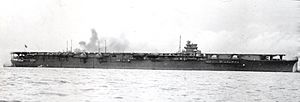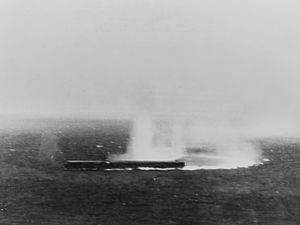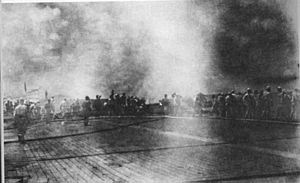Japanese aircraft carrier Shōkaku facts for kids
Shōkaku (which means "Soaring Crane" in Japanese) was a powerful aircraft carrier built for the Imperial Japanese Navy (IJN) just before World War II began in the Pacific. She was the first ship of her kind, with a sister ship named Zuikaku. Together, these two carriers played a big part in many important sea battles during the war. These included the famous attack on Pearl Harbor, the Battle of the Coral Sea, and the Battle of the Santa Cruz Islands. Shōkaku was eventually sunk by the U.S. submarine USS Cavalla during the Battle of the Philippine Sea in 1944.
class="infobox " style="float: right; clear: right; width: 315px; border-spacing: 2px; text-align: left; font-size: 90%;"
| colspan="2" style="text-align: center; font-size: 90%; line-height: 1.5em;" | 
|}
Contents
| History | |
|---|---|
| Name | Shōkaku |
| Namesake | 翔鶴, "Soaring Crane" |
| Builder | Yokosuka Naval Arsenal |
| Laid down | 12 December 1937 |
| Launched | 1 June 1939 |
| Commissioned | 8 August 1941 |
| Fate | Sunk by USS Cavalla, 19 June 1944 |
| General characteristics (as built) | |
| Class and type | Shōkaku-class aircraft carrier |
| Displacement | |
| Length | 257.5 m (844 ft 10 in) |
| Beam | 26 m (85 ft 4 in) |
| Draft | 8.8 m (28 ft 10 in) |
| Installed power | |
| Propulsion | 4 × shafts; 4 × geared steam turbines |
| Speed | 34.2 kn (63.3 km/h; 39.4 mph) |
| Range | 9,700 nmi (18,000 km; 11,200 mi) at 18 knots (33 km/h; 21 mph) |
| Complement | 1,660 |
| Armament |
|
| Aircraft carried |
|
Building and Design
The Shōkaku-class carriers were designed after an important naval agreement, the Washington Naval Treaty, ended in 1936. This meant the Japanese Navy could build carriers without old restrictions. They wanted ships that were very fast, could travel long distances, had strong protection, and could carry many aircraft.
Shōkaku was started at Yokosuka Dockyard on December 12, 1937. She was launched into the water on June 1, 1939, and officially joined the navy on August 8, 1941.
Shōkaku had a modern design. She weighed about 32,000 long tons (33,000 t) and could reach a top speed of 34 kn (63 km/h; 39 mph). She could carry 70 to 80 aircraft. Her strong armor helped her survive serious damage in battles like the Battle of the Coral Sea and Battle of the Santa Cruz Islands.
Hull and Protection
Shōkaku looked like a bigger version of an earlier Japanese carrier, Hiryū. She had a longer and wider body. Her front part (forecastle) was raised to help her handle rough seas better. She also had a wide, rounded bow (front) that kept the flight deck dry in most weather.
The ship's underwater front had a special shape, called a bulbous bow. This shape helped reduce drag in the water, making the ship faster and able to travel further.
Shōkaku was about 10,000 tons heavier than the carrier Sōryū. This was mainly because she had much more armor. Her main armor deck over important areas like engines and fuel tanks was 215 mm (8.5 in) thick. The armor along the sides of the ship was also very strong.
Aviation fuel on Japanese carriers was stored inside the ship's hull. This was different from British carriers, which used separate, safer tanks. This design choice became a problem during the war. Hits or near-misses could damage the fuel tanks, causing dangerous leaks and fires. After the Battle of Midway in 1942, the empty spaces around Shōkaku's fuel tanks were filled with concrete to try and protect them. However, this didn't stop dangerous fumes from spreading if the tanks were hit, as seen when she was sunk.

Engines and Speed
Shōkaku's engines were similar to those on Sōryū, but more powerful. Even with all the extra armor and weight, Shōkaku could still reach a speed of over 34.2 kn (63.3 km/h; 39.4 mph). She could carry enough fuel to travel 9,700 nmi (18,000 km; 11,200 mi) at a speed of 18 kn (33 km/h; 21 mph).
She had two large funnels (smokestacks) on her right side, behind the island (the control tower). These funnels curved downwards to keep smoke away from the flight deck.
Flight Deck and Hangar
Shōkaku's flight deck was 242 m (794 ft) long and made of wood planks. It didn't quite reach the very front or back of the ship.
The ship had three elevators to move aircraft between the flight deck and the two hangars below. The largest elevator was at the front. All elevators could lift planes weighing up to 5,000 kg (11,000 lb) in about 15 to 20 seconds.
To help planes land safely, Shōkaku had nine arrester wires. These wires could stop a 6,000 kg (13,000 lb) aircraft landing at speeds up to 78 knots (144 km/h; 90 mph).
The upper hangar was 623.4 by 65.6 feet (190 by 20 m) and the lower hangar was 524.9 by 65.6 feet (160 by 20 m). Both were about 15.7 feet (4.8 m) high. Together, they could hold 72 aircraft for normal operations, plus 12 spare planes. Unlike some older carriers, the spare planes didn't need to be taken apart, so they could be made ready for flight faster.
After trying islands on the left side of some earlier carriers, the Japanese Navy decided to put the island on the right side for both Shōkaku and Zuikaku.
In September 1942, Shōkaku was the first Japanese carrier to get a radar system. This radar was placed on her island. This new radar helped save Shōkaku a month later during the Battle of the Santa Cruz Islands. It detected U.S. planes early, giving crews time to drain fuel lines before bombs hit. This prevented huge fires and explosions that often sank other carriers.
Weapons
Shōkaku's main defense against enemy aircraft consisted of sixteen 127 mm (5.0 in) Type 89 dual-purpose guns. These guns could shoot at both ships and planes. They were placed in pairs on platforms sticking out from the ship's sides.
For closer defense, she also had twelve triple-mount 25 mm (0.98 in) Type 96 anti-aircraft guns. Over time, more of these 25 mm guns were added to increase her protection against air attacks.
Shōkaku's War Journey
Shōkaku and Zuikaku formed the Japanese 5th Carrier Division. They loaded their aircraft just before the attack on Pearl Harbor. Each carrier carried 18 "Zero" fighters, 27 "Val" dive bombers, and 27 "Kate" torpedo bombers.
These two carriers joined the main Japanese carrier fleet, called the Kido Butai (Mobile Force). They took part in Japan's first attacks of the war, including Pearl Harbor and the attack on Rabaul in January 1942.
In March–April 1942, during the Indian Ocean raid, planes from Shōkaku and the rest of the Kido Butai attacked Colombo, Ceylon. They sank two ships and damaged port facilities. They also found and sank two British heavy cruisers, HMS Cornwall and Dorsetshire, and the aircraft carrier HMS Hermes.
Major Damage and Repairs
The 5th Carrier Division then went to Truk to help with a plan to capture Port Moresby in New Guinea. During this operation, called the Battle of the Coral Sea, Shōkaku's planes helped sink the American carrier USS Lexington. However, on May 8, 1942, Shōkaku herself was badly damaged by dive bombers from USS Yorktown and Lexington. She was hit by three bombs, which caused fires. The fires were put out, but the damage meant Shōkaku had to return to Japan for major repairs.
On her way back, she had to go very fast to avoid American submarines. She took on so much water through her damaged bow that she almost sank in rough seas. She arrived in Japan on May 17, 1942, and was repaired within ten days. Because of these repairs and the loss of aircraft and pilots, both Shōkaku and Zuikaku could not take part in the important Battle of Midway.
After her repairs, Shōkaku and Zuikaku, along with another carrier Zuihō, became the First Carrier Division. They fought in two more battles in 1942. In the Battle of the Eastern Solomons, they damaged USS Enterprise. Then, in the Battle of the Santa Cruz Islands, they badly damaged USS Hornet, which was later sunk by Japanese destroyers.
At Santa Cruz, on October 26, 1942, Shōkaku was again seriously damaged. She was hit by at least three (and possibly up to six) 1,000-pound bombs from American dive bombers. Because her radar had given early warning, her aviation fuel lines had been drained. This prevented major fires from breaking out. However, her flight deck and hangars were a mess, and she couldn't launch planes for the rest of the battle. The need for more repairs kept her out of action for many months.
Final Battle and Sinking
After several months of repairs and training, Shōkaku was sent to the Lingga Islands near Singapore in 1944. On June 15, she left with the Mobile Fleet for Operation "A-Go", a counterattack against Allied forces in the Mariana Islands. Her planes faced strong American defenses and suffered heavy losses.
During the Battle of the Philippine Sea on June 19, 1944, Shōkaku was hit by three (possibly four) torpedoes from the American submarine USS Cavalla. At the time, Shōkaku was refueling and rearming her aircraft, making her very vulnerable. The torpedoes started fires that could not be controlled.
About 48 minutes later, an aerial bomb exploded inside the ship. This caused aviation fuel vapors, which had spread throughout the ship, to explode. The order was given to abandon ship. But before many men could escape, Shōkaku quickly took on water at her front and sank bow-first. She went down at position 11°40′N 137°40′E / 11.667°N 137.667°E, taking 1,272 men with her. The light cruiser Yahagi and destroyers Urakaze, Wakatsuki, and Hatsuzuki rescued 570 men.
Gallery
-
Mitsubishi A6M2 "Zero" fighters from the Shōkaku preparing for the attack on Pearl Harbor.
See also
 In Spanish: Shōkaku para niños
In Spanish: Shōkaku para niños





